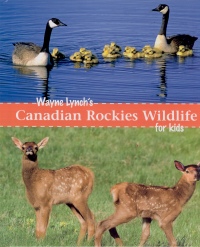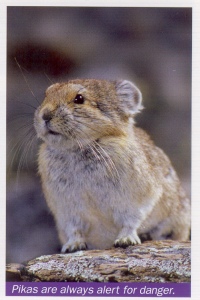| ________________
CM . . . . Volume XVIII Number 2 . . . . September 9, 2011
excerpt:
Wayne Lynch uses his expertise as a photographer and experience as a wildlife observer in this appealing presentation of mountain-dwelling animals for young readers. Detailing interesting features of more than 20 animals found in the Canadian Rockies, the double-page spreads offer facts, a Fast Fact box (size, habitat, diet, Strange but True), Some basic facts introduce each subject, but what makes this book especially fun to read is the variation in treatment which shows how well-tuned the author is to his audience and what might catch their fancy. For instance, Lynch focuses the readers' attention on how aggressive a mother moose is through an anecdote about a biologist witnessing the spirited defense by the mother when a bear attacked her calf. In another section, Lynch offers a detailed explanation of how hibernation works using the example of a marmot. Kid-friendly comparisons abound: it's easy to picture a pika "about the size of a baked potato". As well, kids will easily understand the habitat needs of three types of squirrels because Lynch compares their body shapes, legs and tails. He also anticipates questions kids might have: e.g. what happens when a porcupine gets stuck with its own quills? Photos are top quality, as one has come to expect from this well-known photographer/author. They show both adult and young of the species and give an idea of habitat. Pictures and text in sidebars are closely integrated while showing more features: e.g. horns on mountain goats and bighorn sheep, antlers on moose, lynx ear tufts. Close-ups show porcupine feet, beaver teeth, eagle claws. This book will give the reader a good foundation of facts about Canadian wildlife in the mountainous regions. It includes an introduction that details the four mountain habitat zones and a page of tips to help kids learn how to view wildlife. It can be enjoyed simply for interest, with an added benefit of encouraging kids to ask questions and learn more about the "magical experience" of nature study. Highly Recommended. Gillian Richardson is a freelance writer living in BC.
To comment
on this title or this review, send mail to cm@umanitoba.ca.
Copyright © the Manitoba Library Association. Reproduction for personal
use is permitted only if this copyright notice is maintained. Any
other reproduction is prohibited without permission.
NEXT REVIEW |
TABLE OF CONTENTS FOR THIS ISSUE
- September 9, 2011.
AUTHORS |
TITLES |
MEDIA REVIEWS |
PROFILES |
BACK ISSUES |
SEARCH |
CMARCHIVE |
HOME |

 sidebar and several color photos.
sidebar and several color photos.